| 1 September |
• yesterday • tomorrow |
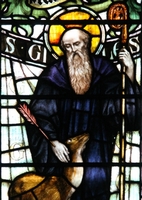
Aegidius, Aegidus, Aigeides, Aigigios, Egidio, Egidius, Egydius, Gil, Gilg, Gilgen, Gilgian, Gilles, Ilg, Ilgen, Jilg
Born to a wealthy noble family, when his parents died, Giles gave his fortune to help the poor. Known as a miracle worker. To avoid followers and adulation, he left Greece c.683 for France where he lived as a hermit in a cave in the diocese of Nimes, a cave whose mouth was guarded by a thick thorn bush, and a lifestyle so impoverished that, legend says, God sent a deer to Giles to nourish him with her milk.
One day after he had lived there for several years in meditation, a royal hunting party chased the hind into Giles’ cave. One hunter shot an arrow into the thorn bush, hoping to hit the deer, but instead hit Giles in the leg, crippling him. The king sent doctors to care for hermit‘s wound, and though Giles begged to be left alone, the king came often to see him.
From this, Gile’s fame as sage and miracle worker spread, and would-be followers gathered near the cave. The French king, because of his admiration, built the monastery of Saint Gilles du Gard for these followers, and Giles became its first abbot, establishing his own discipline there. A small town grew up around the monastery, and upon Giles’ death, his grave became a shrine and place of pilgrimage; the monastery later became a Benedictine house.
The combination of the town, monastery, shrine and pilgrims led to many handicapped beggars hoping for alms; this and Giles’ insistence that he wished to live outside the walls of the city, and his own damaged leg, led to his patronage of beggars, and to cripples since begging was the only source of income for many. Hospitals and safe houses for the poor, crippled, and leprous were constructed in England and Scotland, and were built so cripples could reach them easily. On their passage to Tyburn for execution, convicts were allowed to stop at Saint Giles’ Hospital where they were presented with a bowl of ale called Saint Giles’ Bowl, “thereof to drink at their pleasure, as their last refreshing in this life.”
In Spain, shepherds consider Giles the protector of rams. It was formerly the custom to wash the rams and colour their wool a bright shade on Giles’ feast day, tie lighted candles to their horns, and bring the animals down the mountain paths to the chapels and churches to have them blessed. Among the Basques, the shepherds come down from the Pyrenees on 1 September, attired in full costume, sheepskin coats, staves, and crooks, to attend Mass with their best rams, an event that marks the beginning of autumn festivals, marked by processions and dancing in the fields. One of the Fourteen Holy Helpers, the only one not to die as a martyr.
at Athens, Greece
• between 710 and 724 in France of natural causes
• legend says that those who attended his funeral heard choirs of angels singing and then fading away as they carried his soul to heaven
• his tomb is in the crypt of the abbey church of Saint-Gilles in Gard, France
• in 1562, Huguenots burned the abbey, murdered the monks, looted the church, and vandalized the tomb; the surviving relics of Saint Giles were distributed to other churches
• in Scotland in the seventeenth century, his relics were stolen from a church which triggered a great riot
• abandoned people • against abandonment • against breast cancer • against epilepsy • against fear of night • against insanity • against leprosy • against mental illness • against noctiphobia • against sterility • beggars • blacksmiths • breast feeding • cancer patients • disabled people • epileptics • forests • handicapped people • hermits • horses • lepers • mentally ill people • noctiphobics • physically challenged people • paupers • poor people • rams • spur makers • woods • Graz, Austria • Klagenfurt, Austria • Altavilla Silentina, Italy • Camerata Nuova, Italy • Caprarola, Italy • Cavezzo, Italy • Latronico, Italy • Monte San Savino, Italy • Tolfa, Italy • Edinburgh, Scotland
• arrow • cave • crosier • deer, hind, doe, roe • hermitage • Benedictine monk accompanied by a hind • lilies growing in the sand (refers to a legend that says three lilies blossomed in dry sand as Giles explained three points to prove the perpetual virginity of Mary to a doubter)
https://catholicsaints.info/saint-giles/

Juliana
Born to the Italian nobility, the daughter of Count Rambaldo VI and Countess Giovanna of Sant’Angelo of Mantua. She received a Christian education, and at age 12, she entered the Benedictine convent of Santa Margherita di Salarola near Calaone, Italy. There she became a friend of Blessed Beatrix of Este the Elder who entered the convent in 1220. Founded a Benedictine convent on the island of Spinalonga (modern Giudecca) off Venice, Italy, and served as its abbess. Known for her charity and care for the local poor. Late in life she began suffering from severe headaches, possibly migraines, which led to her patronage of others who do.
Blessed Giuliana was reported to be a miracle worker, including –
• instantly healing the shattered broken arm of one of her nuns by praying over her
• she went to the prison cell of an innocent man, opened the prison doors and removed all his chains simply by praying over them
• one Christmas night a severe storm kept the local priest from reaching the convent; Giuliana prayed about the problem; an angel carrying the Christ child appeared to the nuns, announcing the birth of Jesus
1186 in Collalto, Susegana, Treviso, Italy
• 1 September 1262 at Venice, Italy of natural causes
• buried in the cemetery of the San Biagio church of the Spinalonga convent
• the location of her grave was lost, but in 1297, dozens of small flaming torches were seen to hover over it; her body found to be incorrupt
• relics enshrined in a wooden sarcophagus in the church altar in 1733
• relics moved to the church of the Redeemer in Venice in 1810
• relics moved to the Saint Anne chapel at the parish church of Saint Euphemia in Venice in 1820
• the original wooden sarcophagus is on exhibit in the Museo Correr in Venice
• some relics enshrined in a church in Collalto, Italy
20 May 1753 by Pope Benedict XIV (cultus confirmed)
against headaches • against migraines • migraine sufferers
https://catholicsaints.info/blessed-giuliana-of-collalto/
• Douceline of Hyères
• Douceline of Marseille
Daughter of Berengarius of Digne, a prosperous merchant, and Huguette of Barjols; the couple was known for their piety and charity. Following the death of her parents, she moved to Hyères, France, and was drawn to the spirituality of the Franciscans who had recently moved into the area; she sometimes stayed at a Poor Clare convent. She spent her time caring for the sick and poor, and her personal property dwindled to the clothes on her back and a pile of straw she used for a bed.
Learning of the Beguine life, she adopted their habit. She attracted a number of like-minded women who became the community of Beguines in Hyères known as the “Ladies of Roubaud”, named after a river that flowed near where they met. In 1240, Douceline took vows of virginity and poverty, and became leader of the “Ladies”. In 1250, with the invitation and help of her brother, Hugues of Digne, a Franciscan friar who wrote the rule of the group, she established a Beguine house in Marseille, France. Her reputation for holy wisdom spread, she became a counsellor to people of all stations, was known to levitate while in prayer, and though she never joined the Franciscans, the local brothers and sisters considered her one of their own.
1214 in Digne-les-Bains, Provence (in modern France)
• 1 September 1274 in Marseille, France of natural causes
• interred in the the Franciscan church in Marseille next to her brother Hugues
• the bishop of Orange, France delivered her funeral eulogy
• relics transferred to the New Major church when the old one was demolished in 1524
• relics transferred to the new cathedral, built in 1857
Hyères, France
https://catholicsaints.info/blessed-douceline-of-digne/

Leu, Loup, Lowe, Lupo, Wolf
Born to the Burgundian nobility, he was early noted to have a love to Christ and the Church. Nephew of Saint Austremius of Orleans, and Saint Aunarius of Auxerre who both saw to his education. Noted for his love of music and his generosity to the poor. Monk at Lérins. Priest. Archbishop of Sens, Burgundy (in modern France) in 609.
When Lupus hesitated to acknowledge Clotaire II as the rightful ruler of Burgundy, and insisted that the will of God trumps the will of rulers, Clotaire used the excuse of slander about Lupo and a woman to exile him to Ansenne, a predominently pagan area. Lupus evangelized the people of the area, converting many, including the region’s governor. When Lupus’ replacement in Burgundy, the politically ambitious monk Monegisil, was killed during a riot, the people demanded the return of their rightful bishop. Clotaire recalled Lupus, and punished those who had spoken against him.
Legend says that once when celebrating Mass, a jewel descended from heaven into the elevated chalice.
near Orleans, Gaul (in modern France) as Wolf
• 623 in Brienon-sur-Armançon, Yonne, France of natural causes
• buried under the gutter of Saint Columba’s basilica, Sens, France
• relics transferred to the new cathedral on 23 July 853
against epilepsy • of epileptics
https://catholicsaints.info/saint-lupus-of-sens/
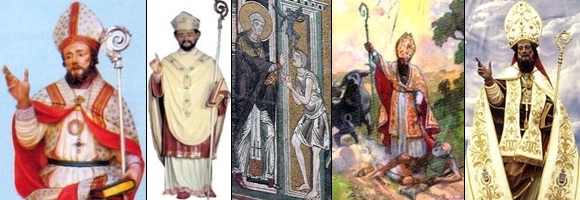
Twelve priests of northern Africa who were driven into exile into Italy by Arian Vandals. There they continued to be outspoken about their faith; all became noted preachers and evangelists, and some bishops in their dioceses. We have a few details about their individual lives, and the areas in which they became patrons. Their names are Adiutor, Augustus, Canion, Castrensis, Elpidius, Heraclius, Marcus, Priscus, Rosius, Secundinus, Tammarus and Vindonius.
https://catholicsaints.info/exiles-of-campania/

Regolo
Evangelising archbishop in North Africa. Exiled with Saint Cerbonius of Populonia and some other Christians to Italy in the persecutions of Arian Vandals. The group settled in the area of Populonia and Piombino, and Regulus lived as a holy and miracle working hermit. Martyred in the persecutions of Totila of the Ostrogoths.
North Africa
• beheaded c.545 in the area of Piombino, Italy
• legend says that Regulus’ body picked up the severed head and walked about 300 yards; where he stopped, the area Christians buried him and built a church dedicated to him
• relics enshrined in the cathedral of San Martino in Lucca, Italy
• Montaione, Italy
• Vagli Sotto, Italy
Metropolitan Chapter of the Cathedral of Saint Martin in Lucca, Italy
https://catholicsaints.info/saint-regulus/
Costantino, Constanzo
Bishop of Aquino, Italy c.465 to c.487. Attended the Council of Rome in 465. Had the gift of prophecy. Pope Saint Gregory the Great wrote about him in the Dialogues, and Peter the Deacon wrote a biography of him.
• c.487 in Aquino, Italy of natural causes
• relics enshrined in a Saint Constantius church outside the walls of the city of Aquino
• relics interred under the altar at the cathedral of Saint Peter in Aquino in 1644
• relics placed in a new wooden reliquary urn and re-interred under the main altar in the cathedral of San Costanzo in Aquino on 10 December 1742
• that cathedral was destroyed in May 1944 during the fighting of World War II
• Aquino, Italy
• Aquino-Pontecorvo, Italy, diocese of
• Sora-Aquino-Pontecorvo, Italy, diocese of
https://catholicsaints.info/saint-constantius-of-aquino/
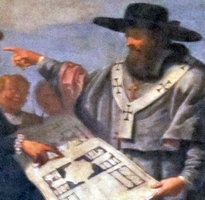
Nivardo, Nivo
Born to the wealthy Gallic nobility, a member of the ruling Merovingians. He served in the imperial court, and was the brother-in-law of King Childeric II of Austria. Priest. Archbishop of Reims, France in 657; he served there for over 20 years. Helped found the abbey of San Pietro di Hautvillers in 662, supported houses in Corbie, Soissons, Fontenelle, and financed the construction of several churches. He finally retired, and spent his final years at the abbey of Hautvillers.
early 7th century near Reims, Gaul (modern France)
1 September 673 at the abbey of San Pietro di Hautvillers of natural causes, and was buried there
https://catholicsaints.info/saint-nivard-of-rheims/

• Madonna di Montevergine
• Madonna Bruna
• Mamma Schiavona
One of the so-called Black Madonnas; this term can refer to an image of the Blessed Virgin Mary, normally holding the Christ Child, that has been "inculturated", that is, made the little Jewish girl Mary look more like the people in the area of the artist, or to images which are actually black in color. This one serves as part of the altar piece of the Sanctuary of the Montevergine in Campania, Italy. This site is the goal for thousands of pilgrims each year.
Montevergine, Mercogliano, Italy
https://catholicsaints.info/our-lady-of-montevergine/
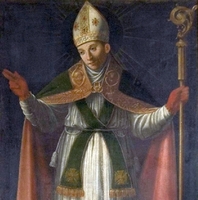
Terenciano, Terentian, Térentien, Terenziano, Terenzio, Terentianus
Priest. Bishop of Todi, Umbria, Italy. Old traditions says that he was tortured on the rack, had his tongue cut out for preaching, and martyred in the persecutions of Hadrian in 118, but it is more likely that he was died in the 4th century.
beheaded in 118
• Capranica, Italy
• Fraore, Italy
• Isola di Compiano, Italy
• Nicorvo, Italy
• Rezzoaglio, Italy
• San Terenziano, Italy
• Teano, Italy
https://catholicsaints.info/saint-terentian/
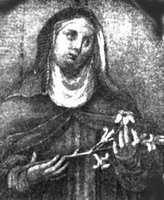
• Giovanna da Firenze
• Jane, Johanna, Juana
Born to the Italian nobility. Spiritual student of Saint Juliana Falconieri. She became a Servite tertiary, attending Mass every morning, in Eucharistic adoration every night. She was known for her life of prayer and austerity, and her devotion to the Passion of Christ, and the Sorrows of the Blessed Virgin Mary.
1301 at Florence, Italy
1 September 1367 in or near Florence, Italy of natural causes
1 October 1827 by Pope Leo XII (cultus confirmation)
https://catholicsaints.info/blessed-jane-soderini/
• Abdon ben-Hillel
• Abed-Dün
The son of Hillel, a Pirathonite, the tenth Judge of Israel, serving for 8 years, as described in the Old Testament Book of Judges. Married, the father of 40 sons, grandfather of 30 children.
in Pirathon
buried in Pirathon
After him Abdon, son of Hillel, the Pirathonite, judged Israel. He had forty sons and thirty grandsons, who rode on seventy donkeys. He judged Israel for eight years. Abdon, son of Hillel, the Pirathonite, died and was buried in Pirathon in the land of Ephraim in the mountain region of the Amalekites. – Judges 12:13-15 (New American Bible Revised Edition)
https://catholicsaints.info/abdon-the-judge/

Prisco
An ancient tradition holds that the Last Supper was held at the house of Priscus in Jerusalem. He may have worked with Saint Peter the Apostle as an evanglizing priest, and was designated by Peter as the first bishop of Capua, Italy where he served for about 20 years. Martyred in the persecutions of Nero.
• c.66
• relics enshrined in the cathedral of archdiocese of Capua, Italy in the early 18th century
San Prisco, Italy
https://catholicsaints.info/saint-priscus-of-capua/
Firminus II, Firman, Firmin
2 January (translation of relics)
His father, Faustinian, was prefect of imperial Roman Gaul and a convert, baptized by Saint Firminus of Amiens; Faustinian named his son Firminus in honour of the saint. Firminus became a priest, and c.350, he was chosen the third bishop of Amiens, France where he served for about 40 years.
• c.390 of natural causes
• buried in the church of Our Lady in Amiens, France; the church has since been renamed for Saint Acheul
• relics translated to the cathedral of Amiens in the 7th century
https://catholicsaints.info/saint-firminus-the-younger/

• Sinicius of Soissons
• Sinicus, Sinice, Sinicio
Evangelizing priest in the regions of Soissons and Reims (in modern France) in the latter 3rd century, working with Saint Sixtus of Reims. Bishop of Soissons, France. Second bishop of Reims, France, serving from 280 to 286.
France
• 286 in the diocese of Reims, France of natural causes
• re-interred in the Church Saint-Rémi de Reims in the 10th century
https://catholicsaints.info/saint-sinicius-of-reims/
Born to the nobility, she was the daughter of the count of Pagliara, Italy, and sister of Saint Bernard Valeara of Teramo. As a teenager, Colomba retired to live as a mountain hermitess in a cave. Near the cave is an imprint in the rock that looks like a hand; tradition says it’s where Colomba grabbed the stone to reach her home of solitude.
1100 in Pagliara, Teramo, Italy
• winter 1116 on Mount Brancastello, Italy of natural causes
• Saint Bernard Valeara of Teramo built a chapel on the site of her hermitage cave
https://catholicsaints.info/blessed-colomba-of-mount-brancastello/

• Joshua the Prophet
• Joshua, son of Nun
• Giosuè, Hosea, Hoshea, Jehoshua, Jesus, Josua, Josue, Josuë, Jozua, Jozuë, Osee, Yehoshu’a, Yehoshúa, Yeshua
Old Testament patriarch. The successor of Moses the Patriarch as leader of the Israelites, he led them into Canaan. Led the Israelite forces that took Jericho.
in pre-Exodus Egypt as Hoshea
c.12th century BC
https://catholicsaints.info/joshua-the-patriarch/
• Ibzan of Bethlehem
• Abesan, Ebzan
Judge of Israel for 7 years, as described in the Old Testament Book of Judges. Married and the father of 30 sons and 30 daughters.
Israelite
buried in Bethlehem
After him Ibzan of Bethlehem judged Israel. He had thirty sons and thirty daughters whom he gave in marriage outside the family, while bringing in thirty wives for his sons from outside the family. He judged Israel for seven years. Ibzan died and was buried in Bethlehem. – Judges 12:8-10 (New American Bible Revised Edition)
https://catholicsaints.info/ibzan-the-judge/

Sisto, Sixte, Xystus
First bishop of Rheims, France, serving from c.260 to c.280.
• c.280 in Rheims, France of natural causes
• buried to the south of Rheims, and a church was soon built at the spot, but it was demolisted in 1726, having stood for about 1400 years
• relics transferred to the abbey basilica of Saint-Remi in 920 by Archbishop Erveo
https://catholicsaints.info/saint-sixtus-of-rheims/

Tàmaro, Tambaro, Tammaro
Priest in North Africa. Tortured and exiled by being stuck in a boat without a rudder and sent out to sea by the Arian Vandals. The boat landed in the Campania region of southern Italy, and he resumed his ministry with the people there.
Grumo Nevano, Italy • San Tammaro, Italy • Villa Literno
https://catholicsaints.info/saint-tammarus-of-campania/

Trained in the law, he taught at the University of Paris, France. Mercedarian secular knight in Valencia, Spain. Assigned to Granada, Spain where he worked to ransom Christians held prisoner by the Moors, and encourage Christians who were about to renounce their faith in fear. Beaten and murdered by Moors for his work. Martyr.
Paris, France
hanged in 1337 in Granada, Spain
https://catholicsaints.info/blessed-giustino-of-paris/
Vittore, Victor
Sub-deacon. Married and the father of one son. Spiritual student of Saint Martin of Tours. At the recommendation of Saint Martin, Victorius was chosen bishop of Le Mans, France c.450; his wife became a nun and Victorius served for approximately 40 years. He attended the Council of Angers in 453, and the Council of Tours in 461. Saint Gregory of Tours wrote about him.
c.490 in Le Mans, Lugden Gaul (in modern France)
https://catholicsaints.info/saint-victorius/

Verena of Zurzach
Related to one of the soldiers of the Theban Legion. Verena travelled to the area of modern Switzerland to search for him. After learning of his death, she settled down to live as an anchoress near Zurich.
Egypt
3rd century
https://catholicsaints.info/saint-verena/
Arcanum, Arcano
With Saint Aegidius of Sansepolcro, he made a pilgrimage to Palestine where they collected relics of the saints, and brought them back to Italy in the mid- to late-10th century. They founded a Benedictine monastery, which grew into Borgo San Sepulcro (modern Sansepolcro), Italy, to house them.
Italy
c.1050 of natural causes
https://catholicsaints.info/saint-arcanus/
Egidio, Giles
With Saint Arcanus of Sansepolcro, he made a pilgrimage to Palestine where they collected relics of the saints, and brought them back to Italy in the mid- to late-10th century. They founded a Benedictine monastery, which grew into Borgo San Sepulcro (modern Sansepolcro, Italy), to house them.
Spain
c.1050 of natural causes
https://catholicsaints.info/saint-aegidius/

Jewish laywoman. Wife of King David. Old Testament matriarch. One of the seven women considered a prophet by the Talmudic scholars.
c.1000 BC
c.950 BC
https://catholicsaints.info/abigail-the-matriarch/

Mercedarian friar. Assigned to the Andalusia region of modern Spain, he suffered abuse from the Moors, but managed to free 137 Christians enslaved by Muslims.
Spain
1359 of natural causes
https://catholicsaints.info/blessed-simone-ponce/
Ambrosinien, Ambrosinia
Bishop from southern Armenia who came to France at an unknown time. He was revered by the parents of Saint Bernard of Clairvaux who dedicated a chapel to him.
relics enshrined in the cathedral of Langres, France
https://catholicsaints.info/saint-ambrosinian-of-armenia/

Mercedarian friar. A doctor of theology, he wrote a number of books about the Mercedarians. Assigned to Algiers in north Africa, he freed 88 Christians who had been enslaved by Muslims.
1372
https://catholicsaints.info/blessed-luigi-conciso/
• Vincent of Dax
• Vincent of Aquae Augustae
First bishop of Dax, France. Worked with Saint Laetus of Dax. Martyr.
Toledo, Spain
5th century
Dax, France
https://catholicsaints.info/saint-vincent-of-xaintes/
Martyred with his sons Carillo and Oderico by invading Lombards.
• c.576 in Brescia, Italy
• relics enshrined in the cathedral in Brescia in 1305
• relics re-located to the cathedral crypt on 8 June 1614
https://catholicsaints.info/saint-arealdo-of-brescia/
Benedictine Cistercian monk. Abbot of the monastery of San Martín de Castaneda. In his old age he retired from community life to live as a prayerful hermits.
Spanish
c.1203 of natural causes
https://catholicsaints.info/blessed-giles-of-castaneda/
Martyred in the persecutions of Maximian Herculeaus.
• c.303 at Sentianum, Italy
• relics enshrined in Benevento, Italy in 760
https://catholicsaints.info/saint-donatus-of-sentianum/
Martyred in the persecutions of Maximian Herculeaus.
• c.303 at Sentianum, Italy
• relics enshrined in Benevento, Italy in 760
https://catholicsaints.info/saint-felix-of-sentianum/
Child martyr.
• in Rome, Italy, date unknown
• interred in the catacombs of Rome
• relics transferred to the church of San Croce in Como, Italy in 1700
https://catholicsaints.info/saint-anea/
Deacon in the diocese of Dax, France. Worked with Saint Vincent of Xaintes.
5th century
https://catholicsaints.info/saint-laetus-of-dax/
Aia, Aye
Married. Mother of Saint Lupus of Sens. Widow.
6th century
https://catholicsaints.info/saint-agia/
Llythaothaw
Two churches in Wales are dedicated to this saint, but no information about him has survived.
https://catholicsaints.info/saint-lythan/
Martyrs of the South
A group of martyrs who died c.303 at various places in southern Italy. In 760 their relics were brought together and enshrined in Benevento, Italy as a group.
• Saint Arontius of Potenza
• Saint Donatus of Sentianum
• Saint Felix of Sentianum
• Saint Felix of Venosa
• Saint Fortunatus of Potenza
• Saint Honoratus of Potenza
• Saint Januarius of Venosa
• Saint Repositus of Velleianum
• Saint Sabinian of Potenza
• Saint Sator of Velleianum
• Saint Septiminus of Venosa
• Saint Vitalis of Velleianum
One tradition describes Saint Boniface of Hadrumetum and Saint Thecla of Hadrumetum as their parents.
https://catholicsaints.info/twelve-holy-brothers/

Thousands of people were murdered in the anti-Catholic persecutions of the Spanish Civil War from 1934 to 1939. I have pages on each of them, but in most cases I have only found very minimal information. They are available on the CatholicSaints.Info site through these links:
•
•
•
•
•
•
•
•
•
•
•
•
•
•
•
•
•
•
•
•
•
•
•
•
•
•
•
•
•
•
• Acasius of Sardinia
• Isabel Cristina Mrad Campos
CatholicSaints.Info Portable Edition